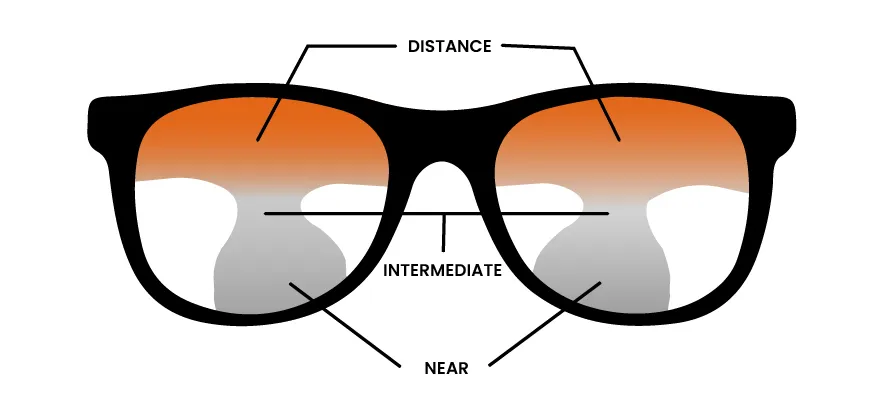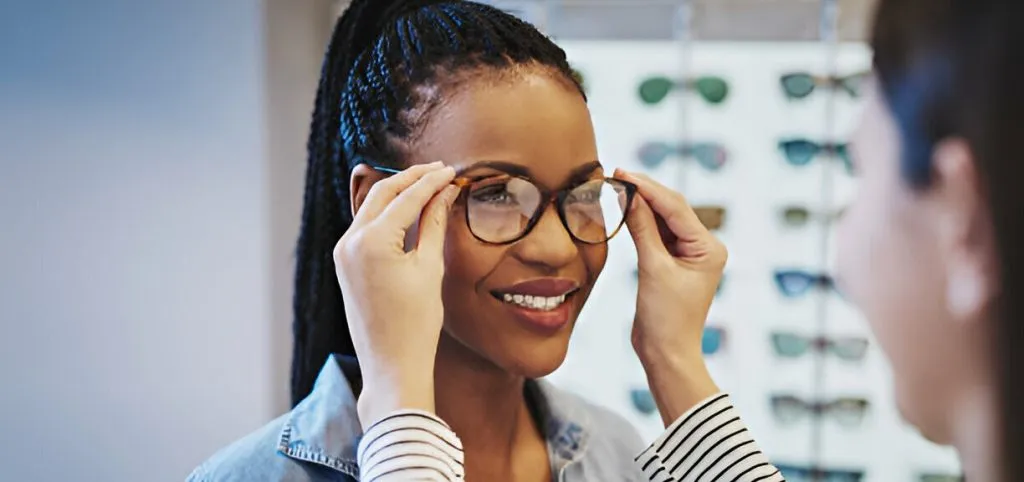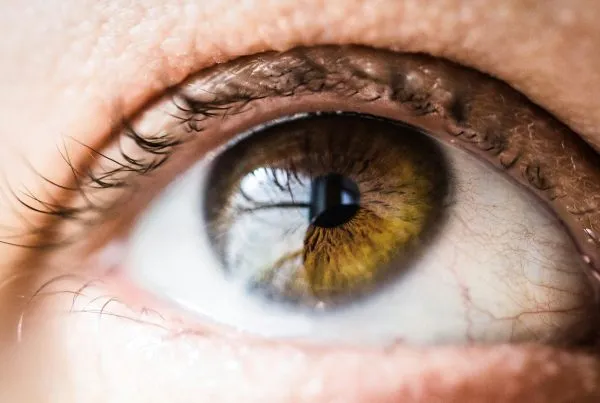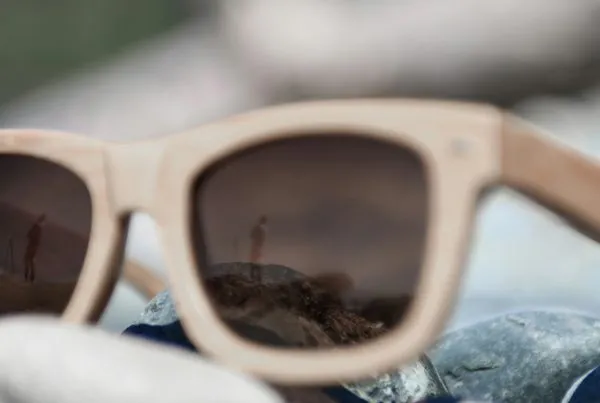Switching between reading and distance glasses can be a hassle, and even alternatives like bifocals or trifocals come with their limitations. This is where varifocal glasses come in, offering a modern, all-in-one solution in a single pair of glasses for clear vision at any distance.
Designed with up to three focal points—near, intermediate, and far—varifocal lenses eliminate the need to carry multiple pairs of glasses, making everyday tasks much more convenient.
So, if you are considering varifocal spectacles, the blog is a complete guide to help you make an informed decision. We’ll explore why varifocal glasses are a game-changer and how to adapt to them effortlessly.
Understanding Varifocal Lenses

Varifocal glasses, also known as varifocals, varifocal lenses, PALs (Progressive Power Lenses), or just progressive lenses. It helps in the simultaneous correction of near and far-sightedness. It gradually changes strength from the top of the lens to the bottom, offering combined correction of distance, intermediate, and reading prescriptions. The seamless transition between vision distances makes for a higher-quality vision correction experience.
The innovative design allows for a more natural and comfortable viewing experience, especially for those who need help with everyday activities. The design, however, has some drawbacks, as it can take time for your brain to adapt.
How Varifocal Glasses Compare with Single-Vision, Bifocal and Trifocal Lenses
Varifocal lens glasses offer a seamless vision solution, but how do varifocals differ from single-vision, bifocals, and trifocals? Let’s have a quick look!
| Varifocal Glasses | Trifocal Glasses | Bifocal Glasses | Single Vision Glasses | |
| Vision Correction | Cover near, far, and intermediate distances | Has three magnification areas: near, far and intermediate | Two distances | One distance |
| Depth Perception | Requires adjustment; may feel distorted | It can cause issues with depth perception | Can cause the image jump at the dividing line | No distortion issues |
| Presbyopia Relief | Yes | Yes | Yes, to some extent | No |
| Aesthetic Appearance | No visible line, a more natural look | Have two visible dividing lines | Visible dividing line | Simple and unobtrusive |
| Cost | Expensive | Less Expensive than Varifocals | Less Expensive than Trifocals | Least Expensive |
Who Can Benefit from Varifocal Glasses?
Varifocal lenses are not for everyone. They are typically only prescribed to people over 40 who need help focusing on nearby objects. Adults over forty naturally develop an eye condition called Presbyopia. It happens because our eye lens loses its flexibility gradually over time. The flexibility is what allows our younger eyes to change their power so that we can read and see things up close.
After losing a small amount each year, eventually, the eyes no longer have enough flexibility left and therefore, the nearby objects appear blurred.
Moreover, you will also need varifocal spectacles in many different situations. You will have to evaluate your vision needs and lifestyle to determine whether you need varifocals.
Varifocals are a great choice in the following conditions.
- You have multiple prescriptions: Varifocal lenses are designed to correct vision problems at multiple distances. Whether you have myopia (nearsightedness), hyperopia (farsightedness), astigmatism, or presbyopia, varifocals eliminate the need for multiple pairs of glasses.
- You experience discomfort with bifocals or trifocals: If the visible line or image jump of bifocals annoys you, a varifocal lens can help by providing a smoother transition. The lenses have no visible lines, providing a more natural and pleasing look.
Types of Varifocal Lenses
When selecting varifocal lenses, it’s essential to choose the type that best meets your visual needs and lifestyle. Here are the five types of varifocal lenses.
- Standard varifocals: A versatile option that delivers balanced performance across all distances. It is a reliable choice for a variety of viewers. They provide clear vision and offer fairly wide focal areas for distance, reading and in-between.
- Elite varifocals: Designed to enhance clarity and comfort, the elite varifocals provide a wider field of vision with minimal distortion. It’s easy to adapt, making it particularly suitable for first-time wearers and those requiring precise vision.
- Occupational varifocals: The type of varifocal lenses is tailored to specific job needs. They are a valuable solution for many professionals. The lenses are spectacles tailor-made and optimised for the designated working distance.
- Supreme varifocals: Supreme is our top-tier option, offering exceptional clarity and the widest field of vision. It is particularly beneficial for those with more complex prescriptions or those who demand the highest quality in lens technology.
- Customized/freeform varifocals: Freeform lenses are designed using advanced computer software for a more precise and personalised vision correction. They are created with a gradual and individualised curvature, allowing for a wider and clearer field of vision.
Advantages of Varifocal Glasses
Varifocal glasses, also known as progressive lenses, offer several benefits for people needing vision correction for near and far distances.
- Versatility: Varifocal glasses eliminate the need to carry multiple glasses for near and far tasks. You can seamlessly switch between distance, intermediate, and near vision without changing your eyewear.
- Aesthetic Appeal: Unlike traditional multifocal lenses, varifocal lens glasses have no visible dividing lines, providing an attractive and modern appearance.
- Cost Effective: They can initially feel expensive; varifocal glasses can save by fitting multiple purposes in a single lens in the long run.
- Natural Vision: The smooth transition between prescription zones in varifocal glasses mimics how your eyes naturally focus. It results in less distortion and a more comfortable viewing experience.
- Improved Peripheral Vision: Unlike bifocals, single vision and trifocals, the varifocals have significantly improved peripheral vision. So, whether walking through crowded places or driving your car, the varifocals are a great help.
- Personalised Fit and Comfort: Varifocals glasses are tailor-made to your exact measurements. It includes head tilt and reading angles. This precise fit minimises discomfort, headaches, and pressure points, allowing you to easily wear your glasses all day.
- Convenience: Varifocal glasses are an all-in-one solution for individuals with presbyopia or multiple vision issues. They reduce the hassle of constantly swapping between reading and regular glasses.
Read a detailed list of benefits of varifocal glasses here.
Common Challenges When Wearing Varifocal Glasses and Solutions

The adjustment period for varifocal lenses varies from person to person, ranging from a couple of days to a few weeks. It’s common to experience some initial challenges during this time. Because it takes time for the eyes to get used to the gradient zones of the lenses, you might feel that your vision feels unusual.
So, here are the common challenges that you might face when wearing varifocal spectacles.
Difficulty Focusing at Different Distances
Problem: One of the most common complaints from new varifocal users is trouble focusing on objects at varying distances. The problem occurs when you are not using the correct part of the lens for each visual task.
Solution: Practice is the only solution. Consciously spend time looking through different parts of the lens. A good exercise is to pick objects at different distances and try focusing on the designated part of the lens to align your eyes for the task.
Eye Strain, Headaches, Discomfort and Dizziness
Problem: New varifocal wearers often experience dizziness, discomfort and headaches during the initial adjustment period as eyes are working harder to adapt to the new visual demands.
Solution: Ensure your lenses have the correct prescription. If symptoms persist beyond a few weeks, consult your optician because your lenses might need a slight adjustment. Moreover, ensure that the lenses are positioned correctly on your nose, as improper alignment can also lead to the problem.
Problem with Depth Perception
Problem: Varifocal lenses may temporarily affect depth perception, making it difficult to judge distances accurately, particularly when going downstairs or placing a cup on a table. It is a common issue impacting activities requiring precise spatial judgment, such as climbing stairs or poring a drink.
Solution: The eyes take some time to adjust to shifting focus between different viewing distances through progressive lenses. So, take extra care during activities that require precise depth perception. Hold onto handrails when using stairs and pause to judge distances consciously until your perception adjusts. The best practice is to perform these activities in safe, controlled conditions to build confidence.
How to Choose the Right Varifocal Glasses?

Varifocal lenses have a transition power, which means that they require precise alignment to ensure that you can see clearly at all distances. Improper alignment of the lenses can cause visual distortion and discomfort.
The size of the frame is crucial because it affects the position of the lenses relative to the eyes. If the frame is too small, you may not have enough room for the different vision zones. If the frame is too large, you may have to move your head more to find the right focus. Frame size also affects how much peripheral distortion you experience around the edges of the lenses.
How to Measure Frame Size?
Five numbers indicate the frame size. The sizes are measured in millimetres.
- Lens Width: The horizontal width of each.
- Bridge Size: The distance between both lenses.
- Temple Length: The length of the arms of the glasses.
- Lens Height: It’s the vertical height of each lens
- Internal Frame Width: The horizontal width of the frame measured from each of the furthest sides.
What is the Ideal Frame Size for Varifocals?
The ideal frame size will depend on the size and shape of the wearer’s face. The frame should be wide enough to accommodate the lenses and ensure proper alignment. The bridge should also fit comfortably on the nose without slipping.
Here is what the ideal frame size for varifocal should feel like.
- The lens height should be at least 30mm to accommodate different vision zones.
- To avoid peripheral distortion and ensure optimal vision, the pupil should be centred horizontally and vertically in the lens.
- The frame should fit comfortably on your nose and ears without slipping or pinching.
Factors to Consider When Choosing the Right Varifocal Glasses
Choosing the right varifocal glasses is about finding the perfect balance of functionality, comfort, and style to match your lifestyle and visual needs.
Here are the factors to consider when choosing the right varifocal lens glasses.
- Budget: Varifocal glasses are available at different price points. Premium options offer better comfort and vision but come at a higher cost.
- Understand Lens Types: Choose between Premium, Elite, and Supreme varifocals based on your vision needs and budget.
- Select the Right Frames: Choose frames that fit your face comfortably and align with your style. It should provide adequate lens space for a smooth transition between vision zones.
- Enhance with Coatings: Enhance your lenses with anti-reflective, scratch resistance, UV, polarised, and blue light protection for added functionality.
- Consult an Expert: Work with a trusted optician to ensure precise measurements and personalised recommendations.
- Match Your Lifestyle: Discuss your daily activities to find varifocals tailored to reading, driving, or digital screen use.
Care and Maintenace for Your Varifocal Glasses

Taking your glasses off, putting the glasses in your pocket without a cover, cleaning the lenses with your shirt, and using your breath for a quick buff are all bad habits. However, with our helpful tips, you can effectively care for your prescription varifocal glasses.
Take them Off Using Both Hands
Frequently, using one hand to remove your glasses can loose the temples, and then they will sit crooked on your face. The best practice is to use two hands to remove your glasses and prevent your hands from touching the lenses.
Hold the glasses from both arms and remove your glasses. Avoid unnecessary stretching of the frames to prevent damage.
Ensure Regular Cleaning
Cleaning is crucial to keep your glasses free from dirt, smudges, and debris. Use a gentle lens cleaner and lukewarm water to clean your glasses. Pat them dry with a clean, lint-free, or microfibre cloth to prevent scratches.
Avoid harsh chemicals or rough materials that can damage the lenses or frames. Moreover, we recommend cleaning your glasses daily to maintain optimal vision and clarity.
Proper Storage
It is important to store your varifocal lenses to protect them from damage. Store them in a sturdy case to protect your glasses from scratches, dust, and accidental impacts.
Avoid placing your glasses face down on hard surfaces or exposing them to extreme temperatures, as it can damage the frames and lenses.
Don’t Wear them on Top of your Head
Wearing glasses on top of your head may seem like the easiest way to keep track of them. But this habit can de-shape the arms of your frames, making them loose and distorted.
We recommend placing them face up on a hard, clean surface or storing them in the case. Getting a glass cord is even better. Simply wear them around your neck to keep track of your glasses.
FAQs
How long does it take to get used to varifocal glasses?
Varifocal glasses take some time to get used to. It can take a few days to a couple of weeks for your eyes to adapt to the different viewing areas.
Why are my Varifocals Blurry?
If you experience some blurriness around the edges of your varifocal glasses, this is nothing to worry about. It typically gets fixed in a few days as the eyes adjust.
There can be a few reasons if your varifocals are blurry even after a couple of weeks.
- The edges of varifocal lenses can be blurry due to peripheral distortion.
- The prescription is too high; the lens might need to be changed.
- Glasses may be small or large. They might not fit properly, which causes you to look through the wrong part of the lens.
How expensive are varifocals?
Varifocals come with a higher price tag, and there are several reasons behind that price point.
- They have a sophisticated computer-aided design and milling techniques to create smooth transitions.
- Unlike standard glasses, varifocals need to be customised to match the prescription and frame shape.
- Varifocal lenses provide a wide and clear field of vision at all distances.
- They are made of premium materials like high-index plastics to minimise thickness and distortion.
What is the alternative to varifocals?
Bifocal, trifocal, and occupational lenses are all alternatives to varifocal lenses. Every spectacle that can fix two or more vision errors is an alternative to varifocals.
Can you watch TV with varifocals?
The top part of the varifocal glasses is designed for distance vision, which is ideal for driving, watching television, walking around, and other similar things. So, yes, you can watch TV with varifocals.
Varifocal Lenses, The Ultimate Vision Solution
Varifocal glasses are a modern, versatile solution for individuals requiring multiple vision prescriptions. It seamlessly blends near, intermediate, and far vision correction into one lens. While some initial adjustment is required, they eliminate the need for multiple pairs of glasses.
Varifocals are meticulously developed to provide a natural vision and personalised comfort. So, if you have multiple prescriptions and are looking for a pair of glasses, choose varifocals that can fix near, far and intermediate vision in one frame.






